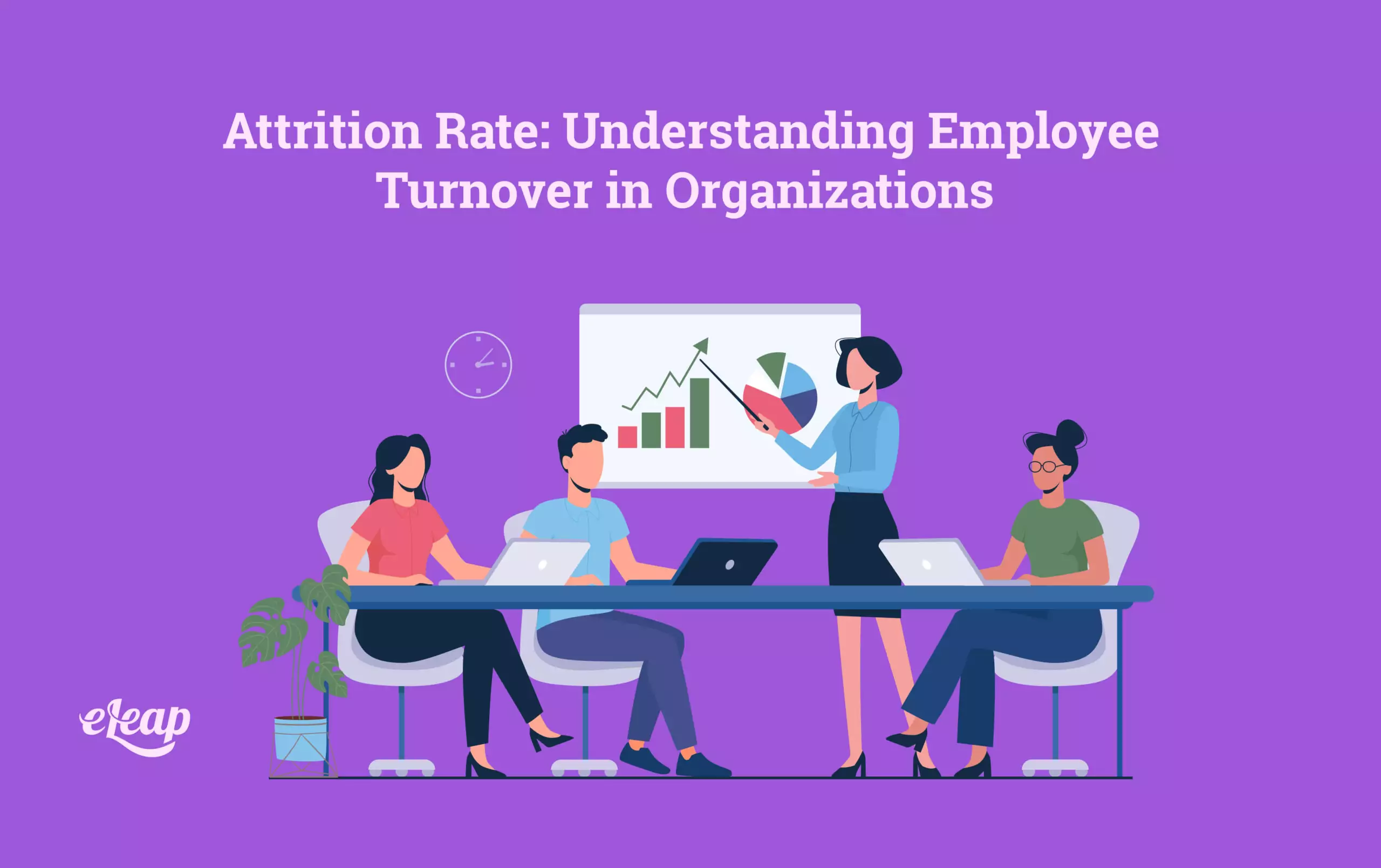Attrition Rate: Understanding Employee Turnover in Organizations

The attrition rate is when employees leave or separate from an organization over a specific period, typically expressed as a percentage. It measures workforce turnover and is commonly used in human resources to analyze employee retention rate and understand the impact on staffing levels.
Voluntary Attrition :
Voluntary attrition refers to employees who leave an organization on their own accord. This could be due to various reasons, such as career advancement opportunities, job dissatisfaction, personal reasons, or pursuing new challenges outside the organization.
Involuntary Attrition:
Involuntary attrition occurs when employees are separated from an organization without their consent. This could include terminations, layoffs, or dismissals due to performance issues, restructuring, or other organizational factors.
Attrition Rate Calculation
The attrition rate is calculated by dividing the number of employees who have left the organization during a given period by the average number of employees during that same period. The result is then multiplied by 100 to obtain the attrition rate percentage.
Churn Rate:
Churn rate is a term sometimes used interchangeably with attrition rate. It specifically refers to the rate at which customers or clients stop using a product or service. In human resources, the churn rate can describe the rate employees leave a company.
Attrition Analysis:
Attrition analysis involves studying the reasons behind employee departures and analyzing trends to identify patterns and potential areas of improvement. It helps organizations gain insights into the factors contributing to attrition and develop strategies to enhance employee retention.
Early Attrition:
Early attrition refers to employees leaving an organization shortly after joining, often within the first few months of employment. It may indicate recruitment, onboarding, or fit job issues and can concern organizations aiming to retain new hires.
Attrition Risk:
Attrition risk refers to the likelihood of employees leaving an organization within a specific timeframe. HR professionals can identify high-risk individuals or positions by assessing attrition risk and taking proactive measures to mitigate potential attrition, such as implementing retention strategies or addressing underlying issues.
Attrition Cost:
Attrition cost refers to the financial impact associated with employee turnover. It encompasses various expenses, including recruitment, training, lost productivity, and knowledge transfer. Understanding attrition costs can help organizations quantify the impact of attrition and make informed decisions regarding retention efforts.
Attrition Forecasting:
Attrition forecasting involves predicting future attrition rates based on historical data, trends, and other relevant factors. By forecasting attrition, organizations can proactively plan for staffing needs, identify potential talent gaps, and implement strategies to mitigate turnover.

Factors Affecting Attrition Rate
- Job Satisfaction and Engagement
- Career Advancement Opportunities
- Compensation and Benefits
- Work-Life Balance
- Organizational Culture and Leadership
- Employee Development and Training
- Communication and Feedback
- Workload and Stress Levels
- Employee Recognition and Rewards
- Relationships with Managers and Colleagues
Calculating Attrition Rate
- The formula for Attrition Rate Calculation
- Average Number of Employees
- Period Consideration
- Types of Attrition
- Voluntary Attrition
- Employee Resignations
- Pursuing Higher Education or Career Change
- Personal Reasons and Relocation
- Involuntary Attrition
- Layoffs and Downsizing
- Terminations and Dismissals
- Retirement
Understanding Attrition Patterns and Trends
- Early Attrition
- Challenges in Onboarding and Integration
- Misalignment of Expectations
- High-Performing Employees
- Factors Influencing Retention of Top Talent
- Strategies for Retaining High Performers
- Attrition by Department or Team
- Identifying Areas with Higher Turnover Rates
- Addressing Team-Specific Issues
- Seasonal or Cyclical Attrition
- Industries with Seasonal Demand Fluctuations
- Planning and Mitigating Seasonal Attrition
- Impact of Attrition on Organizations
- Financial Implications
- Cost of Recruitment and Onboarding
- Lost Productivity and Knowledge
- Training and Development Expenses
- Organizational Culture and Morale
- Employee Engagement and Satisfaction
- Team Dynamics and Collaboration
- Impact on Remaining Employees
- Succession Planning and Talent Pipeline
- Identifying Potential Successors
- Knowledge Transfer and Retaining Institutional Memory
Strategies for Managing Attrition
- Enhancing Employee Engagement
- Regular Feedback and Communication
- Recognition and Rewards Programs
- Creating a Positive Work Environment
- Career Development and Growth Opportunities
- Training and Skill Enhancement Programs
- Internal Mobility and Promotions
- Succession Planning
- Work-Life Balance Initiatives
- Flexible Work Arrangements
- Employee Wellness Programs
- Stress Management Support
- Competitive Compensation and Benefits
- Market Research and Benchmarking
- Performance-Based Incentives
- Health and Retirement Benefits
- Improving Leadership and Managerial Skills
- Training for Managers
- Transparent and Supportive Leadership
- Empowering Employees
Attrition Forecasting and Analysis
Predictive Modeling for Attrition
Analyzing Historical Data and Trends
Actionable Insights for HR Strategies
Conclusion
In conclusion, understanding and managing attrition rate is crucial for organizations to maintain a stable and engaged workforce. By identifying the factors influencing attrition, calculating attrition rates, and implementing effective strategies, businesses can enhance employee retention, reduce costs, and foster a positive work environment.
FAQs (Frequently Asked Questions)
What is the ideal attrition rate for organizations?
The ideal attrition rate varies across industries but ranges between 10% and 15%. However, it is essential to consider industry norms and specific organizational contexts.
How can organizations address early attrition?
Organizations can focus on improving onboarding processes, providing clear job expectations, and offering mentorship programs for new employees to address early attrition.
What are some common retention strategies?
Common retention strategies include enhancing employee engagement, providing growth opportunities, ensuring work-life balance, offering competitive compensation, and improving leadership skills.
How can organizations forecast attrition rates?
Organizations can forecast attrition rates by analyzing historical data, identifying trends, conducting employee surveys, and using predictive modeling techniques.
What are the consequences of high attrition rates?
High attrition rates can result in increased recruitment and training costs, reduced employee morale, decreased productivity, and difficulties in succession planning.